|
|
|
Sort Order |
|
|
|
Items / Page
|
|
|
|
|
|
|
| Srl | Item |
| 1 |
ID:
144200
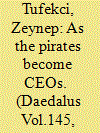

|
|
|
|
|
| Summary/Abstract |
The early Internet witnessed the flourishing of a digitally networked public sphere in which many people, including dissidents who had little to no access to mass media, found a voice as well as a place to connect with one another. As the Internet matures, its initial decentralized form has been increasingly replaced by a small number of ad-financed platforms, such as Facebook and Google, which structure the online experience of billions of people. These platforms often design, control, influence, and “optimize” the user experience according to their own internal values and priorities, sometimes using emergent methods such as algorithmic filtering and computational inference of private traits from computational social science. The shift to a small number of controlling platforms stems from a variety of dynamics, including network effects and the attractions of easier-to-use, closed platforms. This article considers these developments and their consequences for the vitality of the public sphere.
|
|
|
|
|
|
|
|
|
|
|
|
|
|
|
|
| 2 |
ID:
144199
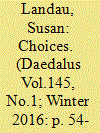

|
|
|
|
|
| Summary/Abstract |
The Internet's original design provided a modicum of privacy for users; it was not always possible to determine where a device was or who was using it. But a combination of changes, including “free” Internet services, increasing use of mobile devices to access the network, and the coming “Internet of Things” (sensors everywhere) make surveillance much easier to achieve and privacy more difficult to protect. Yet there are also technologies that enable communications privacy, including address anonymizers and encryption. Use of such technologies complicate law-enforcement and national-security communications surveillance, but do not completely block it. Privacy versus surveillance in Internet communications can be viewed as a complex set of economic tradeoffs–for example, obtaining free services in exchange for a loss of privacy; and protecting communications in exchange for a more expensive, and thus less frequently used, set of government investigative techniques–and choices abound.
|
|
|
|
|
|
|
|
|
|
|
|
|
|
|
|
| 3 |
ID:
144195
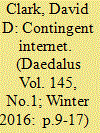

|
|
|
|
|
| Summary/Abstract |
The Internet is so omnipresent and pervasive that its form may seem an inevitability. It is hard to imagine a “different” Internet, but the character of the Internet as we experience it today is, in fact, contingent on key decisions made in the past by its designers, those who have invested in it, and those who have regulated it. With different choices, we might have a very different Internet today. This paper uses past choices made during the emergence of the early Internet as a lens to look toward its future, which is equally contingent on decisions being made today: by industry, by governments, by users, and by the research community. This paper identifies some of those key choices, and discusses alternative futures for the Internet, including how open, how diverse, how funded, and how protective of the rights of its users it may be.
|
|
|
|
|
|
|
|
|
|
|
|
|
|
|
|
| 4 |
ID:
144196
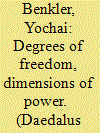

|
|
|
|
|
| Summary/Abstract |
The original Internet design combined technical, organizational, and cultural characteristics that decentralized power along diverse dimensions. Decentralized institutional, technical, and market power maximized freedom to operate and innovate at the expense of control. Market developments have introduced new points of control. Mobile and cloud computing, the Internet of Things, fiber transition, big data, surveillance, and behavioral marketing introduce new control points and dimensions of power into the Internet as a social-cultural-economic platform. Unlike in the Internet's first generation, companies and governments are well aware of the significance of design choices, and are jostling to acquire power over, and appropriate value from, networked activity. If we are to preserve the democratic and creative promise of the Internet, we must continuously diagnose control points as they emerge and devise mechanisms of recreating diversity of constraint and degrees of freedom in the network to work around these forms of reconcentrated power.
|
|
|
|
|
|
|
|
|
|
|
|
|
|
|
|
| 5 |
ID:
144201
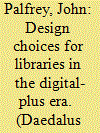

|
|
|
|
|
| Summary/Abstract |
Libraries are more important, not less so, in a digitally networked era. Despite the fact that today's mobile devices feature Google's search box and Apple's Siri to help us find a quick answer to just about any question, we ought to be investing more capital than ever in our public libraries. We need libraries in the digital era to provide a public option to ensure sustained, free, equitable access to knowledge and preservation of our cultural and scientific heritage. In a period when both the analog and digital are useful, the design choices for those building, and reimagining, libraries are many and complex. We ought to design our libraries to meet the near-term possibilities of a networked environment, as well as the long-term requirements of democratic societies and the practice of scholarship. These design choices involve trade-offs and new commitments that may pit future activities against entrenched present-day interests. The essential design choice is between reliance on ever-more efficient interfaces, often developed by commercial outfits, and interfaces that are developed by the library community, engaging the public in coproduction and extending outward via the networked public sphere. The fate of libraries as vibrant institutions with broad public support could turn on the outcome of these design decisions. The challenges facing libraries also inform conversations about the future of other public-facing institutions, such as schools and newspapers, which are important contributors to an informed citizenry and a vital republic.
|
|
|
|
|
|
|
|
|
|
|
|
|
|
|
|
| 6 |
ID:
144197


|
|
|
|
|
| Summary/Abstract |
This paper considers how existing concepts underlying the development of the Internet are being strained in the emerging Internet of Things (IoT). It also explores how the well-known and tried Domain Name Service concepts, which map hierarchic names to addresses, can be extended for the IoT. The extension greatly broadens the concept of name/address mapping to digital objects with identifier/attribute database mapping for physical objects, applications, and data. Finally, this essay discusses the properties of the identifier management systems, showing how scalability, security, and flexibility can be supported in the IoT.
|
|
|
|
|
|
|
|
|
|
|
|
|
|
|
|
| 7 |
ID:
144198
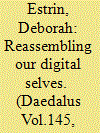

|
|
|
|
|
| Summary/Abstract |
Digital applications and tools that capture and analyze consumer behaviors are proliferating at a bewildering rate. Analysis of data from large numbers of consumers is transforming advertising, generating new revenue streams for mobile apps, and leading to new discoveries in health care. In this paper, we consider a complementary perspective: the utility of these implicitly generated data streams to the consumer.
|
|
|
|
|
|
|
|
|
|
|
|
|
|
|
|
|
|
|
|
|